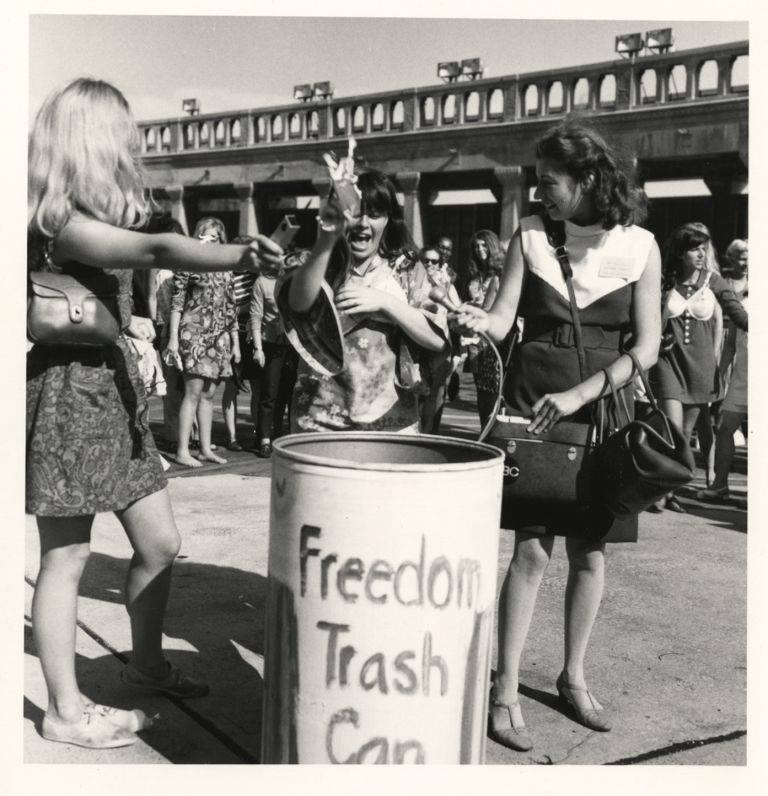
Today in Feminist History is our daily recap of the major milestones and minor advancements that shaped women’s history in the U.S.—from suffrage to Shirley Chisholm and beyond. These posts were written by, and are presented in homage to, our late staff historian and archivist, David Dismore.
September 7, 1968: The “Miss America Pageant” – and perhaps America itself – will never be quite the same again.

Out on Atlantic City’s Boardwalk, as well as inside Convention Hall, voices of protest were raised at an event dedicated to promoting the illusion of ever-smiling feminine contentment, and eager conformity to the limited roles assigned to women in a patriarchal society.
This was by far the most elaborate and successful event yet staged by the Women’s Liberation Movement, and the fact that what by today’s standards was a relatively small group of totally nonviolent protesters could generate such vast, nationwide press coverage shows that this is an issue whose time has come.
The plans for the demonstration were announced just as the pageant’s preliminary competitions were beginning three days ago. They were discussed with reporters by one of the protest’s organizers, Robin Morgan. Among the top objections to the pageant were its “degrading mindless boob-girlie symbol” which epitomizes the roles women are supposed to play when competing for male approval, and the overt racism shown by the fact that every finalist since the pageant began in 1921 has been Caucasian.
The demonstration ran from early afternoon until late into the evening. A major center of attention was the “Freedom Trash Can,” which represented the idea that women can only be free when ludicrous beauty standards and stereotyped roles have been discarded. Into the container went all the items of oppression suggested by organizers in their flyers: ” … bras, girdles, curlers, false eyelashes, wigs and representative copies of Cosmopolitan, Ladies Home Journal, and Family Circle,” plus detergent, high-heeled shoes, and a ripped-up copy of Playboy tossed in for good measure.
But unlike anti-war protests, where draft cards are frequently burned, nothing in the trash can was meant to go up in smoke, although this idea was apparently under consideration – then rejected – in the days leading up to the protest.
The largest exhibit was a huge puppet, in a red, white and blue bathing suit, designed by Mike Dobbins, and chained to Bonnie Allen and Florika representing ” … the chains that tie us to these beauty standards against our will.” Near the end, Bonnie did some comedic primping to point out the time, money and effort white women are urged to spend curling their hair, and Black women straightening theirs.
Signs read: “Welcome To The Miss America Cattle Auction,” “I Am A Woman, Not A Toy, Pet Or Mascot,” and “Who Dares Judge Beauty?” Perhaps the most symbolic action was the crowning of a live sheep as Miss America.
The protests were not limited to Atlantic City’s Boardwalk. As last year’s winner gave the standard farewell speech that could have been – and probably was – given in 1948 or 1928, the Convention Hall’s balcony erupted with something unprecedented: 16 demonstrators shouting: “Freedom for Women!” and “No More Miss America!” as they quickly unfurled and hung a banner reading: “Women’s Liberation.” They were quickly hustled out, with Naomi Jaffee, Carol Jones, and three others under arrest. The first arrest occurred earlier, when Peggy Dobbins was squirting a vial of Toni Home Permanent – one of the pageant’s sponsors – at the floor and under the seats of the audience.
Today was a day of guerrilla theater, singing, symbolism and protest. It was also a signal to the world that the feminist movement in the U.S. did not die out when the suffrage amendment was ratified in 1920, and that the battle for equal dignity, respect, and opportunity for all is far from over.
Modern supporters of women’s rights now know that even so impregnable a citadel of traditional women’s roles as the Miss America Pageant can be breached. Its glorification of conformity, and celebration of youth, thinness and white skin as the only definitions of beauty, and beauty as the principal way to judge a woman’s worth, can be transformed through protest into a platform for a day-long expression of what a wide spectrum of true beauty and life choices really exist.
Nothing is immune from criticism now, so today should be only the first of many such colorful demonstrations as a new generation of feminists boldly makes its own contributions to the long battle to end stereotyping and discrimination!





